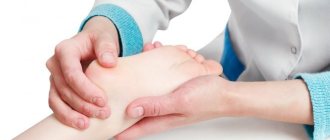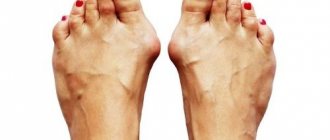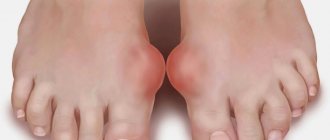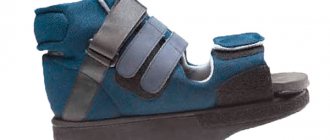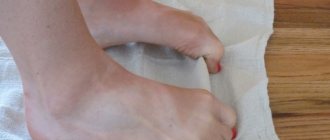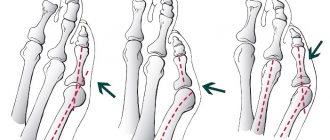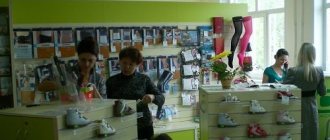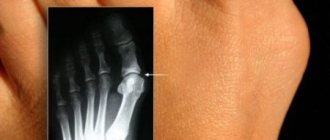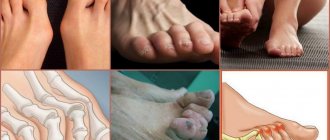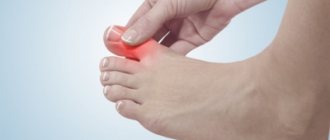Treatment
Gymnastics for the bunion on the big toe
07/23/2018 Arina Sokh No Comments
- 5.1 Writing with your feet
An interfering bone in the foot can be removed not only through surgery. If you do not delay visiting an orthopedist or traumatologist, then in the early stages of the disease they will recommend gymnastic exercises. A newly appeared bump on the side of the foot can completely disappear if you regularly do foot exercises.
Gymnastics for feet with hallux valgus
Specially designed exercises for getting rid of a bunion on the big toe help activate all the muscles of the feet. If a person walks long distances, this does not indicate that absolutely all the muscle tissues on the foot are working. Staying on your feet for a long time (shoes that compress the feet are added to the aggravating circumstances), monotonous posture contributes to the growth of the bone, since the tendons that support the joint in the correct location do not cope with their job.
Massage the bumps on the big toe
Physical education will help activate sedentary muscles and develop them. This will be a good prevention and treatment at the first symptoms of a bunion on the foot. Exercise therapy is also prescribed in the postoperative period.
Daily exercise
This complex serves to reduce bones, relieve pain and swelling. Daily use of these exercises will relieve discomfort while walking and sleeping.
To begin with, if you have the opportunity, do exercises to strengthen the entire foot. To do this, we stand on our toes, straighten our posture and mentally imagine as if we are being pulled up by the top of our head, and begin to walk in different directions for half a minute to a minute.
Then we walk on the outer surface of the foot, also starting with a small amount, gradually increasing to a minute. Then on the inner surface so that. Then on your heels. This way our foot is strengthened on all sides. Also, to strengthen the veins, walk sideways.
Next, we take a chair, put our feet on our toes and sit on our knees, so that the emphasis on the floor rests on our bent toes, and we sit. This exercise is quite painful for the foot, but it stretches the muscles, which helps get rid of the bunion. The procedure should begin with five seconds and gradually increase to a minute.
To perform the next exercise you need to take a chair. Place your hands on the back of the chair and begin rolling onto your heels, onto your toes, and onto your knees. This procedure should be repeated for ten minutes. Then squat down and perform circular movements with your feet. In this case, your knees should be kept as low as possible. You need to perform the exercise for two minutes clockwise and two counterclockwise.
Gymnastics should be performed before bed, after lubricating your legs with castor oil. It is recommended to use salt foot baths after gymnastics.
How exercises will help
Feet are designed to be supported and moved around. Systematic physical activity ensures the health of the lower extremities and the entire body as a whole.
Special exercises for the appearance of a bone on the foot perform the following tasks:
- reduce pain in the feet when moving;
- train and increase the tone of muscles and ligaments;
- activate the toes;
- help the joint to return to its normal position and reduce bumps.
Physical exercises for hallux valgus
Hallux valgus and varus deformity of the foot
It is necessary to immediately clarify that there are several foot deformities:
1) so-called hallux valgus , when the foot is rotated when walking so that it takes weight on the inner arch of the foot. Because of this, the big toe begins to move to the side. This occurs under the influence of biomechanics to maintain balance and mobility of the foot.
2) there is a varus deformity of the foot , when the foot takes weight on the outer arch of the foot. In this case, the joints of the little toes may become deformed.
That is, first you need to understand what pathologies exist that cause a growth on the foot.
Many people believe that heels, tight and bad shoes are to blame. No, that's not the root cause. Although shoes are one of the factors that influences the appearance of bunions.
Important! To correct any pathologies associated with foot deformities, exercises for the foot itself are not enough. Complex training is required, with work on the knee joints, hips, hip joints, sacrum and then the entire spine. This is the whole essence of the biomechanics of joint movements.
Rules for performing exercises
The results from doing the exercises will appear only when they are performed systematically, without missing classes. Gymnastics should be carried out in the volume recommended by the orthopedic doctor.
If you have a small bone in your foot, you can do gymnastic exercises during working hours during your lunch break.
By following basic rules, you can achieve good results:
- Do gymnastics every day without skipping.
- Do all the exercises from start to finish, stick to the number of times recommended by your doctor.
- Exercises for the feet should be done 2 times a day (in the mornings and evenings).
Rules for performing exercises
The effectiveness of gymnastics for the feet was noticed in the initial stages of pathology.
The benefits of exercise therapy
A set of exercises can be used for healthy feet as a preventive measure.
At the first manifestations of the disease, physical therapy is the main method of fighting for the beauty of the legs.
The complex is prescribed by an orthopedic doctor after examining the patient and determining the severity of the disease. In the exercise therapy room, the physiotherapist is obliged to show and explain the technique for performing them.
Such gymnastics will help relieve not only pain, but also fatigue after a working day.
If all the doctor’s instructions are correctly followed, the patient can notice the first results within 2-3 weeks. Pain may decrease, muscle tone will increase, and ligaments will become stronger.
You should not stop doing the exercises after getting the desired result. Gymnastics after treatment must be continued and done constantly, reducing the frequency of exercises.
Exercises
Gymnastics for the bunion on the big toe is not quite ordinary in the usual sense. But the technique for performing them is not complicated, you just need to get used to doing exercises with developing pathology.
Exercise must become a habit, and then the bone on the finger will begin to go away.
Let's take a closer look at the example exercises.
Lump on foot near big toe
Paper ball
Form small pieces of paper into lumps and place on the floor. Lift them with your toes and transfer them to your hands. Perform for the right and left legs the same number of times. You can replace paper lumps with other small objects (pebbles, pencils, toys). The process in which the joints are involved is important here.
Fan
Starting position – the big toes of both feet are in close contact with each other. To perform the exercise, the toes of the right foot are spread to the right in the form of a fan and linger for some time in this position. Do the same for the left leg to the left. Repeat – 5 times. Initially, you can help your little fingers by holding them with your hands.
Physical exercises for hallux valgus
Alphabet
Perfect for doing after a night's sleep. Lie on your back, raise your entire leg or just your feet. Write letters in the air with your finger. At first, they start with a few letters, each time increasing their number and so gradually writing down all the letters of the alphabet.
Clenching your toes into a fist
Can be done from any starting position. You can sit or stand. Bring both knees and both feet together. Use your fingers to make an impromptu fist, bringing it together with force. During execution, the muscles of the feet should tense. Stay in this position for a short time, then straighten your fingers and relax. Repeat several times.
This exercise also has a more complex version - when clenching your fingers into a fist, you need to try to bend them in the opposite direction. Feel the tension, relax.
Treatment of a bunion on the big toe
Technique for performing gymnastics from the bunion
Before performing gymnastics, it is recommended to fully warm up, massage your feet, and apply warming ointment to them. These exercises are not difficult to perform, which allows you to perform them while watching a movie or working at the computer.
The following exercises for the big toe joint are the most effective:
- Picking up small things using your thumb. This may not be easy on your first attempts, so it is recommended to scatter soft and easily squeezable things. These can be lumps of paper, small pillows, soft balls, toys. You can gradually complicate the task by collecting smaller and slippery objects.
- Exercise “bicycle” - a modification of this exercise will strengthen the calf and metatarsal muscles. In this case, you need to alternately straighten your feet and pull your toes forward. The required position is lying or sitting on the floor with straightened legs.
- In a lying position, the sore leg is raised and all the letters of the alphabet, numbers or other characters are written in the air with an outstretched thumb.
- A more advanced version of the previous exercise involves writing letters with a pencil or pen held by your big toe. At first it may not work out, then you can draw simple geometric shapes. In the future, it is recommended to complicate your task by drawing counterclockwise, or writing letters in reverse order.
- Walking on your toes, heels and the outside of your feet. To begin with, it is recommended to walk on a soft surface so as not to cause discomfort, then you can step on a hard floor or pebbles, if you can visit the beach. First you need to rise on your toes, straighten your back, raise and pull your arms up. Stand in this position for about 10 seconds, then start walking. After toes, walk on your heels, arms should be at your sides, and your back should be straight. The last stage is walking on the outer side of the foot. You should not try to stand on the inside of your foot, as this may complicate the course of the disease.
- In a sitting position, with your legs and back straight, you need to spread your toes in different directions. At the peak of extension, you need to fix your fingers and hold for about a minute. If this is easy, the time can increase to 3-5 minutes.
- Gymnastics for the bunion on the big toe with an elastic band will help train the intertarsal, adductor and flexor muscles. To do this, you need a strong and elastic elastic band; we hook one edge of it onto the thumb, and hold the other in our hands. Then you need to bend and straighten your finger. You can also take a rubber ring and hook it onto the big toes of both feet. After that, in a sitting position with straightened legs, try to spread your feet in different directions, while your heels should be motionless.
- Standing barefoot on the floor, with your big toes and heels touching, rise onto your toes. You need to stand in this position for up to 30-40 seconds. Then stand on the entire surface of the foot, spreading your legs. In this case, the fingers should move apart, you need to fixate in this position for a minute, then repeat everything again.
Simple and fun exercises
There are many exercises that you can enjoy doing. The more fun and enjoyable it is to do gymnastics, the better the movements will be. Some of them may seem complicated at first; coordination of movements is difficult, but over time, everything will be successful in a playful way, and the desired muscle will be “warmed up.”
We write with our feet
Put a sheet of paper and a felt-tip pen, pen or pencil on the floor, it doesn’t matter what; the main thing is to write well on the sheet. Raise the felt-tip pen with your foot, pressing it with the first two toes. Write the numbers of the first ten. Putting a dot between them is the easiest way and gives a short pause. This exercise is performed standing on one leg. Do the same for the other foot.
Exercises for bunions on the big toe
Bottle rolling
The exercise is simple and can be done anywhere while you are sitting. Fill a plastic bottle with sand or water to add weight. Roll with each foot one at a time. Can be replaced with other suitable items: balls, a rolling pin for dough, a ball of thread.
Is it possible to get rid of a lump without surgery?
A protruding bunion on the big toe leads to a defect in the entire foot and pain in the area of this bunion. In addition, the defect prevents you from wearing nice shoes.
Why does the bone grow? This finger bears more stress than the others. The joint begins to swell, then grow additional tissue. This may be caused by tight shoes or smaller shoes. Ladies who constantly wear excessively high heels may also encounter this problem.
Practicing physician and yogi Vyacheslav Smirnov suggests performing special gymnastics to prevent the formation of a bone at the base of the thumb. In addition, this practice will help improve the condition of the entire musculoskeletal system.
A mobile, soft musculoskeletal system means an easy gait, a straight back, a healthy spine.
Exercises you can do at work
While at work, you can not waste time and stretch your feet.
- Starting position - sitting on a chair, feet pressed to the floor, knees connected. You should move your feet under the table, then under the chair. In this case, only the fingers work. When moving forward with your fingers, you need to grab the floor and pull your foot towards you; in the opposite direction, your fingers gather as if into a fist, rest against the floor and push the foot away.
- The starting position is the same. Lifting only the first toes. The rest do not leave the floor at this time. Hold for a few seconds, then relax.
- Perform the previous exercise, then lift the rest to your thumbs. Stay, relax.
- The first fingers are on the floor, raise the rest up, hold them, lower them.
- Place all fingers on the floor, relax the leg muscles. Repeat 5 times.
Reviews and recommendations from doctors
The vast majority of orthopedic doctors, traumatologists, and surgeons speak positively about the benefits of therapeutic exercises for the toes and note its effectiveness at the first signs of the development of hallux valgus.
At the same time, experts recommend adhering to a healthy lifestyle, spending more time in the fresh air, and eating right. They also pay attention to the choice of comfortable shoes and avoidance of too high heels. Together, these measures will help in the fight against pathology and maintaining the health of the feet.
5 / 5 ( 1 voice )
Reasons for the appearance of “bumps” on the legs
- Joint diseases, all kinds of arthrosis, exostoses, bursitis, flat feet and much more can lead to an increase in the bone on the foot;
- Genetics: in many cases, this disease is inherited;
- Disruption of the endocrine system;
- Tight or incorrectly selected shoes (this risk zone includes women who, neglecting their health, prefer high heels);
- Various foot or lower leg injuries, congenital defects, as well as the results of dislocations, or improper healing of bones after fractures;
- Certain activities (such as ballet) place increased pressure on the forefoot and may increase the chances of developing a deformity.
